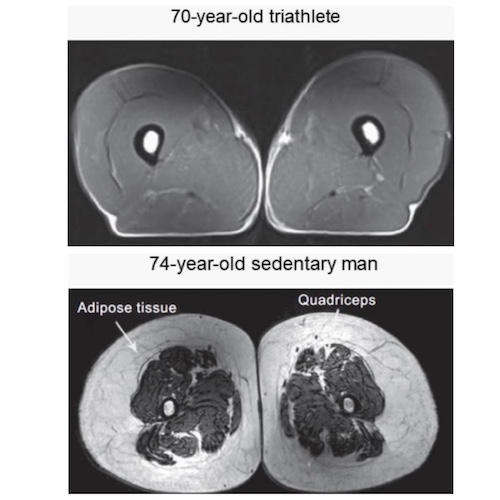Why Muscle Matters: Preventing Sarcopenia and Staying Strong After 30
Hey, guys! Today, we’re talking about something that can totally change how you see your body: muscles (and sarcopenia)! And no, this isn’t about getting too muscular or bulky. The truth is: muscles are key for your health and even your beauty, especially after 30. Let’s explore why that is and maybe take a step toward feeling stronger and more confident. Ready? Let’s go!
Muscles as an Endocrine Organ: More Than Just Strength

Now, let me tell you something really cool that you might have never heard before: our muscles aren’t just responsible for the strength we use to lift weights or climb stairs. They actually function like real hormone powerhouses!
Did you know that muscles release substances called “myokines” when they contract? These myokines act like messengers that help regulate blood sugar, control inflammation, and keep our metabolism in balance. This means that when you move, you’re not just working on your strength; you’re also helping your body function better overall.
So, the next time you’re working out, remember: you’re doing more than burning calories. You’re literally having a conversation with your body, giving it a little nudge to become healthier and more balanced. And that’s one of the reasons why building and maintaining muscles is essential—not just for your appearance, but for your overall well-being.
The Importance of Muscle in Maturity: How Sarcopenia Affects Us Over Time
As we age, we lose muscle mass—a process known as sarcopenia. You might notice tasks like carrying groceries or getting up becoming harder. MRI images clearly show how muscle mass, bone density, and fat tissue change over time.

At 35, muscle mass is dense and surrounds the bones, with very little fat around the muscle tissue. This strong muscle presence provides stability, strength, and helps maintain a fast metabolism.
By 55, muscle mass decreases slightly, and fat tissue starts to accumulate around the muscles. It’s common to see this shift if strength training isn’t consistently maintained. The muscle is still functional, but it’s not as dense as it was at 35.
At 85, the difference is dramatic. Muscle mass is significantly reduced, and fat tissue has increased. This leads to less strength, more fragility, and a higher risk of falls or fractures. The bones are less protected, and overall functionality declines without the support of strong muscles.
Now, take a look at this comparison: two individuals, both 70 years old. One leads a sedentary lifestyle, and the other exercises regularly. The difference in muscle mass and fat is striking. The active individual has retained much more muscle and has less fat, while the sedentary person shows clear signs of muscle degradation. This shows that aging isn’t just about time; it’s about the choices we make.

The takeaway? Muscle loss can start as early as your 30s due to sarcopenia, but you can prevent it by adding strength training to your routine. Strong muscles protect your bones, improve balance, and even reduce the risk of diseases like osteoporosis, type 2 diabetes, and cognitive decline. Building and maintaining muscle is essential for a healthy, active life as you age.
How Building Muscle Helps in Fat Loss: Best Way to Decrease Belly Fat
Want to burn fat? Build muscle! The more muscle mass you have, the more energy your body burns, even at rest. Muscles require more energy to maintain, so by strengthening them, you’re not only getting toned but also burning calories more efficiently—even while you relax.
If you’re looking to lose weight with no loose skin, building muscle is key. This is because the muscle keeps your skin firm as you shed fat. So, don’t just focus on diet or cardio; strength training is essential for fat loss and maintaining a toned body. Whether you’re trying to reduce your big belly or just lose excess fat, building muscle should be part of your strategy.
Beauty and Muscle: How a Toned Body Can Transform Your Appearance

Toned muscles give your body that firm, sculpted look many of us desire. And no, strength training won’t make you bulky—that’s a myth! Women don’t have enough testosterone to bulk up. Instead, strength training creates a lean, defined body. Think about how much better your favorite clothes will look with a toned body. Plus, muscles improve your posture, making you stand taller and feel more confident!
Muscles help you feel more youthful, and can even fight against the visible signs of sarcopenia by maintaining muscle tone and strength as you get older. They also promote better posture, which means you’ll not only look better but feel better too.
How to Adjust Your Diet for Building Lean Muscle: Avoiding Loose Skin During Weight Loss
To build muscle, you need the right fuel. Focus on protein sources like eggs, chicken, fish, and beans, along with carbs like sweet potatoes and oats to energize your workouts. Don’t forget healthy fats from avocado and olive oil, which help your muscles grow and recover. A balanced diet will help you see real, lasting results!
Remember that if you’re trying to lose weight no loose skin, you’ll need to ensure that your diet supports muscle-building. This will help your skin stay firm and elastic, avoiding that saggy feeling that often accompanies weight loss. Incorporate protein in every meal and focus on a nutrient-dense diet to fuel both your workouts and muscle growth.

Actionable Tips to Beat Sarcopenia: How to Start Today
Let’s not wait until it’s too late! Sarcopenia is a gradual process, but with consistent effort, you can reverse muscle loss and even gain strength. Here are a few tips to get started:
1. Strength Training: Make It a Priority
Strength training should be at the heart of your fitness routine, especially after 30. It’s not just about building muscle for aesthetic reasons—it’s about building a stronger, more resilient body that can handle the challenges of everyday life. Starting with two or three sessions a week is a great way to build momentum without overwhelming yourself. Focus on compound movements like squats, deadlifts, and push-ups. These exercises engage multiple muscle groups simultaneously, meaning you get more “bang for your buck.”
Squats, for example, target your legs, glutes, and core, making them an excellent movement for overall muscle growth. Deadlifts, on the other hand, are great for your back, legs, and even your grip strength. Push-ups, an accessible bodyweight exercise, work your chest, shoulders, and arms. By incorporating these compound exercises into your routine, you’ll not only build muscle mass but also improve coordination, stability, and balance. Over time, your body will adapt, and your metabolism will become more efficient, helping you to burn fat while you build muscle.
Start with lighter weights and progressively increase the load as your body gets stronger. Keep your form in check, and don’t forget to warm up before each session to prevent injury. Make strength training a non-negotiable part of your week—it’s one of the most powerful tools in preventing sarcopenia, the loss of muscle mass that begins as early as your 30s.

2. Protein Intake: Ensure You’re Eating Enough
Protein is the building block of muscle, and it becomes even more crucial as we age. As you engage in strength training, your muscles are undergoing tiny tears that need to be repaired and rebuilt. Without adequate protein, your body won’t have the resources it needs to recover and grow stronger.
To support muscle growth, aim for at least 1.6 grams of protein per kilogram of body weight per day. For example, if you weigh 70 kg (around 154 pounds), you should aim to consume at least 112 grams of protein daily. This may sound like a lot, but it’s entirely doable with the right food choices.

Lean meats like chicken, turkey, and fish are excellent sources of high-quality protein. If you prefer plant-based options, beans, lentils, tofu, and quinoa are also packed with protein. Don’t forget dairy products like Greek yogurt and cottage cheese, or protein-rich snacks like nuts and seeds. For those who struggle to get enough protein through whole foods alone, protein powders can be a helpful supplement. Just be sure to choose ones with minimal added sugars or artificial ingredients.
Incorporating a steady intake of protein throughout the day, especially after workouts, is essential for muscle recovery. A post-workout meal or shake that includes both protein and carbohydrates can help kickstart the recovery process, replenishing energy stores and aiding in muscle repair.
3. Recovery: Don’t Neglect Rest
It’s easy to fall into the trap of thinking that the more you work out, the more muscle you’ll gain, but the truth is that muscles grow when you’re resting, not while you’re training. Strength training creates tiny tears in your muscle fibers, and during rest, your body rebuilds them, making them stronger and more resilient.
One of the biggest mistakes people make is not giving themselves enough recovery time. While training hard is important, adequate sleep and recovery days are equally crucial to muscle growth and preventing injuries. Aim for 7 to 9 hours of sleep each night to allow your body to fully recover and repair itself. Sleep is when your body releases growth hormone, which is essential for muscle recovery and repair.
Rest days are equally important. Your muscles need time to rebuild after intense strength training. Overtraining can lead to burnout, injury, and even muscle loss, which is the opposite of what you’re trying to achieve. On recovery days, you can still stay active by doing light activities like walking, yoga, or stretching, but give your muscles a break from the heavy lifting.
Stretching and foam rolling after workouts can also aid in muscle recovery, reduce soreness, and improve flexibility. Your muscles need love and attention not only during workouts but also during the recovery phase.
📖 Want to burn calories in sleep? Check out this must-read article! 👉 Click here
🎬 Prefer to watch? We’ve got an amazing video on this — don’t miss it! 🎥 Watch now
4. Stay Consistent: The Key to Success
Consistency is the secret sauce to building muscle and preventing sarcopenia. You won’t see overnight results, and that’s completely normal. Just like any other health goal, the journey to stronger muscles takes time and dedication.
Building muscle is a long-term commitment that requires a balanced combination of strength training, proper nutrition, recovery, and consistency. It’s easy to get discouraged if you don’t see immediate results, but the key is sticking with it. Every workout you complete, every protein-packed meal you eat, and every night of restful sleep is a step toward achieving your goal.
Track your progress, celebrate small wins, and stay patient. Remember, muscle-building isn’t a sprint, it’s a marathon. Over time, you’ll start to see and feel the difference. Your body will become stronger, your posture will improve, and your energy levels will rise. Plus, you’ll be protecting yourself from sarcopenia, helping to keep your muscles intact and functioning well as you age.
Don’t skip a workout, don’t neglect your nutrition, and don’t let setbacks throw you off course. Consistency is the most important factor in achieving lasting results.

Building Strength to Prevent Sarcopenia and Keep Aging at Bay
Remember, cardio alone won’t build muscle. It’s great for endurance, but resistance training—using weights or even your body weight—is what strengthens and tones muscles. So, whether you’re aiming for better health, reducing belly fat, or a more defined look, don’t skip the weights! Keep working to build strength, and you’ll protect yourself from sarcopenia and stay stronger as you age.
